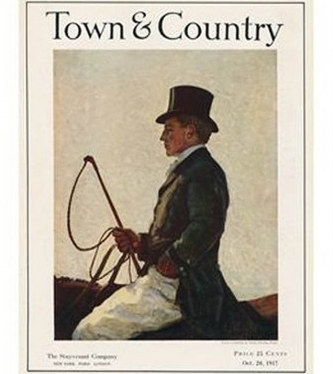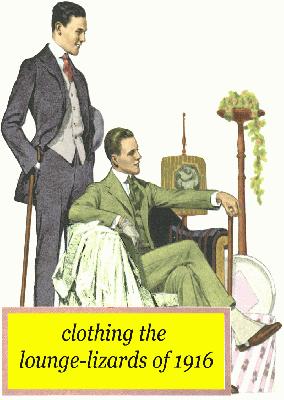|
Men's Fashion Film Clips   In our era, we don't think it terribly odd to see someone in an art museum dressed as though they were going to go poll-vaulting standing next to someone else who is clothed as if they were intending to rope a steer. This sort of untraditional-tradition began in the twenties. The attached link will show you a magazine advertisement for men's knickers which appeared at a time when this sort of thinking began to evolve and "knickerbockers" began a new life as an in-town and on-campus fashion choice. Previously, knickers were worn by young boys or strictly for men who enjoyed country sports; other examples of similar active-ware abuse in the Twenties involved the clothing of yachtsmen, hunters and tennis players. This era saw the rise of the sportswear industry. This 1922 men's fashion article is illustrated with seven images and riddled with wise words for all those seeking information regarding 1920s backless vests, patent leather dancing shoes, madras dress shirts and kid suede gloves for semi-dress wear. Tom Wolf and Mark Twain have not been the only men to have lamented the drab hues so prevalent in manly attire: now you may add to that list a new name: H. Dennis Bradley. The late Mr. Bradley was a tailor in London's Old Bond Street some time back, and he was quite vocal concerning the issue of men's fashions. Being a true "man of the cloth", Mr. Bradley was certain that, prior to the unpleasantness of 1914, men's fashions were headed in a healthy and aesthetically sound direction, but when the boys came home, the promise was not kept. "We may not go back to the rainbow shades and wonderful stuffs of the bucks and the dandies of olden times--do what we will, we live in utilitarian days--but whatever comes do not let us revert to the hideous hues and shapelessness of the Victorian era..." Click here to read a 1929 article about the Dress-Reform Movement. The "Side-Seam" suit style had it's appeal in the early Twenties and could be found in many a magazine in the form of vests and overcoats, however the look did not survive the era and is now numbered among the Zoot Suit and Leisure Suit as one of the forgotten fads of Twentieth Century mode. On page one of this three page guide, you will find some essential notes and illustrations from the editors of Vanity Fair regarding the good taste of 1918 (as well as the simply awful). The following must have been some sort of creative writing project for one of the many bored World War One Doughboys, however it clearly spells out how the necessities of modern war demanded that the wrist watch no longer be thought of as a piece of jewelry adorned only by fops and fems and evolved into a useful tool for soldiers on the field and men with masculine responsibilities. The column makes it quite clear that prior to the Great War, a good many wrist watch enthusiasts would have had their noses broken if they had worn the 'gimmick' into certain neighborhoods.
|
MORE ARTICLES >>> PAGE: * 1 * 2 * 3 * 4 * 5 * 6 * 7 * 8 * > NEXT |
 "0"> "0"> |
|
|
|
|